Lap-Pui Chau
Nanyang Technological University, Singapore
Towards Blind Bitstream-corrupted Video Recovery via a Visual Foundation Model-driven Framework
Jul 30, 2025Abstract:Video signals are vulnerable in multimedia communication and storage systems, as even slight bitstream-domain corruption can lead to significant pixel-domain degradation. To recover faithful spatio-temporal content from corrupted inputs, bitstream-corrupted video recovery has recently emerged as a challenging and understudied task. However, existing methods require time-consuming and labor-intensive annotation of corrupted regions for each corrupted video frame, resulting in a large workload in practice. In addition, high-quality recovery remains difficult as part of the local residual information in corrupted frames may mislead feature completion and successive content recovery. In this paper, we propose the first blind bitstream-corrupted video recovery framework that integrates visual foundation models with a recovery model, which is adapted to different types of corruption and bitstream-level prompts. Within the framework, the proposed Detect Any Corruption (DAC) model leverages the rich priors of the visual foundation model while incorporating bitstream and corruption knowledge to enhance corruption localization and blind recovery. Additionally, we introduce a novel Corruption-aware Feature Completion (CFC) module, which adaptively processes residual contributions based on high-level corruption understanding. With VFM-guided hierarchical feature augmentation and high-level coordination in a mixture-of-residual-experts (MoRE) structure, our method suppresses artifacts and enhances informative residuals. Comprehensive evaluations show that the proposed method achieves outstanding performance in bitstream-corrupted video recovery without requiring a manually labeled mask sequence. The demonstrated effectiveness will help to realize improved user experience, wider application scenarios, and more reliable multimedia communication and storage systems.
EVA02-AT: Egocentric Video-Language Understanding with Spatial-Temporal Rotary Positional Embeddings and Symmetric Optimization
Jun 17, 2025Abstract:Egocentric video-language understanding demands both high efficiency and accurate spatial-temporal modeling. Existing approaches face three key challenges: 1) Excessive pre-training cost arising from multi-stage pre-training pipelines, 2) Ineffective spatial-temporal encoding due to manually split 3D rotary positional embeddings that hinder feature interactions, and 3) Imprecise learning objectives in soft-label multi-instance retrieval, which neglect negative pair correlations. In this paper, we introduce EVA02-AT, a suite of EVA02-based video-language foundation models tailored to egocentric video understanding tasks. EVA02-AT first efficiently transfers an image-based CLIP model into a unified video encoder via a single-stage pretraining. Second, instead of applying rotary positional embeddings to isolated dimensions, we introduce spatial-temporal rotary positional embeddings along with joint attention, which can effectively encode both spatial and temporal information on the entire hidden dimension. This joint encoding of spatial-temporal features enables the model to learn cross-axis relationships, which are crucial for accurately modeling motion and interaction in videos. Third, focusing on multi-instance video-language retrieval tasks, we introduce the Symmetric Multi-Similarity (SMS) loss and a novel training framework that advances all soft labels for both positive and negative pairs, providing a more precise learning objective. Extensive experiments on Ego4D, EPIC-Kitchens-100, and Charades-Ego under zero-shot and fine-tuning settings demonstrate that EVA02-AT achieves state-of-the-art performance across diverse egocentric video-language tasks with fewer parameters. Models with our SMS loss also show significant performance gains on multi-instance retrieval benchmarks. Our code and models are publicly available at https://github.com/xqwang14/EVA02-AT .
3DGeoDet: General-purpose Geometry-aware Image-based 3D Object Detection
Jun 11, 2025Abstract:This paper proposes 3DGeoDet, a novel geometry-aware 3D object detection approach that effectively handles single- and multi-view RGB images in indoor and outdoor environments, showcasing its general-purpose applicability. The key challenge for image-based 3D object detection tasks is the lack of 3D geometric cues, which leads to ambiguity in establishing correspondences between images and 3D representations. To tackle this problem, 3DGeoDet generates efficient 3D geometric representations in both explicit and implicit manners based on predicted depth information. Specifically, we utilize the predicted depth to learn voxel occupancy and optimize the voxelized 3D feature volume explicitly through the proposed voxel occupancy attention. To further enhance 3D awareness, the feature volume is integrated with an implicit 3D representation, the truncated signed distance function (TSDF). Without requiring supervision from 3D signals, we significantly improve the model's comprehension of 3D geometry by leveraging intermediate 3D representations and achieve end-to-end training. Our approach surpasses the performance of state-of-the-art image-based methods on both single- and multi-view benchmark datasets across diverse environments, achieving a 9.3 mAP@0.5 improvement on the SUN RGB-D dataset, a 3.3 mAP@0.5 improvement on the ScanNetV2 dataset, and a 0.19 AP3D@0.7 improvement on the KITTI dataset. The project page is available at: https://cindy0725.github.io/3DGeoDet/.
Revealing the Intrinsic Ethical Vulnerability of Aligned Large Language Models
Apr 07, 2025Abstract:Large language models (LLMs) are foundational explorations to artificial general intelligence, yet their alignment with human values via instruction tuning and preference learning achieves only superficial compliance. Here, we demonstrate that harmful knowledge embedded during pretraining persists as indelible "dark patterns" in LLMs' parametric memory, evading alignment safeguards and resurfacing under adversarial inducement at distributional shifts. In this study, we first theoretically analyze the intrinsic ethical vulnerability of aligned LLMs by proving that current alignment methods yield only local "safety regions" in the knowledge manifold. In contrast, pretrained knowledge remains globally connected to harmful concepts via high-likelihood adversarial trajectories. Building on this theoretical insight, we empirically validate our findings by employing semantic coherence inducement under distributional shifts--a method that systematically bypasses alignment constraints through optimized adversarial prompts. This combined theoretical and empirical approach achieves a 100% attack success rate across 19 out of 23 state-of-the-art aligned LLMs, including DeepSeek-R1 and LLaMA-3, revealing their universal vulnerabilities.
ANNEXE: Unified Analyzing, Answering, and Pixel Grounding for Egocentric Interaction
Apr 02, 2025



Abstract:Egocentric interaction perception is one of the essential branches in investigating human-environment interaction, which lays the basis for developing next-generation intelligent systems. However, existing egocentric interaction understanding methods cannot yield coherent textual and pixel-level responses simultaneously according to user queries, which lacks flexibility for varying downstream application requirements. To comprehend egocentric interactions exhaustively, this paper presents a novel task named Egocentric Interaction Reasoning and pixel Grounding (Ego-IRG). Taking an egocentric image with the query as input, Ego-IRG is the first task that aims to resolve the interactions through three crucial steps: analyzing, answering, and pixel grounding, which results in fluent textual and fine-grained pixel-level responses. Another challenge is that existing datasets cannot meet the conditions for the Ego-IRG task. To address this limitation, this paper creates the Ego-IRGBench dataset based on extensive manual efforts, which includes over 20k egocentric images with 1.6 million queries and corresponding multimodal responses about interactions. Moreover, we design a unified ANNEXE model to generate text- and pixel-level outputs utilizing multimodal large language models, which enables a comprehensive interpretation of egocentric interactions. The experiments on the Ego-IRGBench exhibit the effectiveness of our ANNEXE model compared with other works.
OccProphet: Pushing Efficiency Frontier of Camera-Only 4D Occupancy Forecasting with Observer-Forecaster-Refiner Framework
Feb 21, 2025



Abstract:Predicting variations in complex traffic environments is crucial for the safety of autonomous driving. Recent advancements in occupancy forecasting have enabled forecasting future 3D occupied status in driving environments by observing historical 2D images. However, high computational demands make occupancy forecasting less efficient during training and inference stages, hindering its feasibility for deployment on edge agents. In this paper, we propose a novel framework, i.e., OccProphet, to efficiently and effectively learn occupancy forecasting with significantly lower computational requirements while improving forecasting accuracy. OccProphet comprises three lightweight components: Observer, Forecaster, and Refiner. The Observer extracts spatio-temporal features from 3D multi-frame voxels using the proposed Efficient 4D Aggregation with Tripling-Attention Fusion, while the Forecaster and Refiner conditionally predict and refine future occupancy inferences. Experimental results on nuScenes, Lyft-Level5, and nuScenes-Occupancy datasets demonstrate that OccProphet is both training- and inference-friendly. OccProphet reduces 58\%$\sim$78\% of the computational cost with a 2.6$\times$ speedup compared with the state-of-the-art Cam4DOcc. Moreover, it achieves 4\%$\sim$18\% relatively higher forecasting accuracy. Code and models are publicly available at https://github.com/JLChen-C/OccProphet.
Fuzzy-aware Loss for Source-free Domain Adaptation in Visual Emotion Recognition
Jan 26, 2025Abstract:Source-free domain adaptation in visual emotion recognition (SFDA-VER) is a highly challenging task that requires adapting VER models to the target domain without relying on source data, which is of great significance for data privacy protection. However, due to the unignorable disparities between visual emotion data and traditional image classification data, existing SFDA methods perform poorly on this task. In this paper, we investigate the SFDA-VER task from a fuzzy perspective and identify two key issues: fuzzy emotion labels and fuzzy pseudo-labels. These issues arise from the inherent uncertainty of emotion annotations and the potential mispredictions in pseudo-labels. To address these issues, we propose a novel fuzzy-aware loss (FAL) to enable the VER model to better learn and adapt to new domains under fuzzy labels. Specifically, FAL modifies the standard cross entropy loss and focuses on adjusting the losses of non-predicted categories, which prevents a large number of uncertain or incorrect predictions from overwhelming the VER model during adaptation. In addition, we provide a theoretical analysis of FAL and prove its robustness in handling the noise in generated pseudo-labels. Extensive experiments on 26 domain adaptation sub-tasks across three benchmark datasets demonstrate the effectiveness of our method.
SignEye: Traffic Sign Interpretation from Vehicle First-Person View
Nov 18, 2024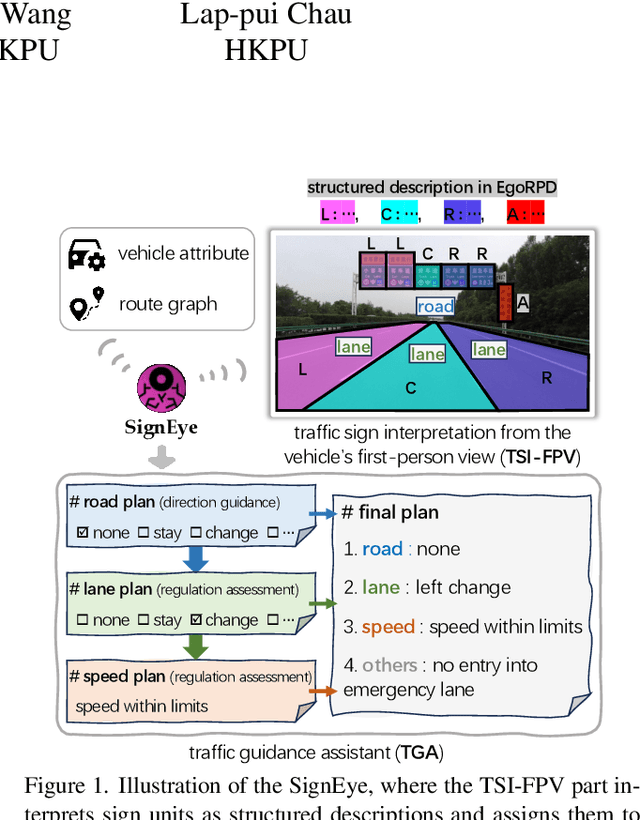
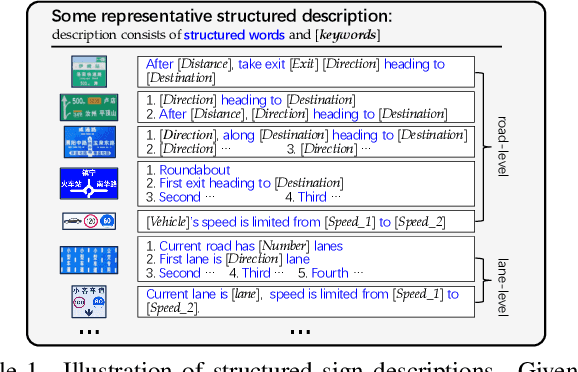
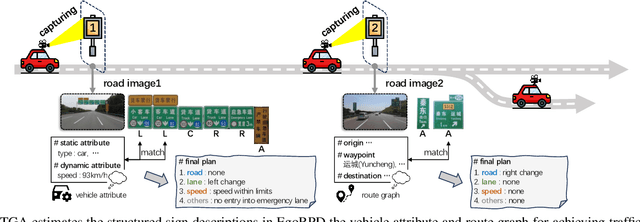
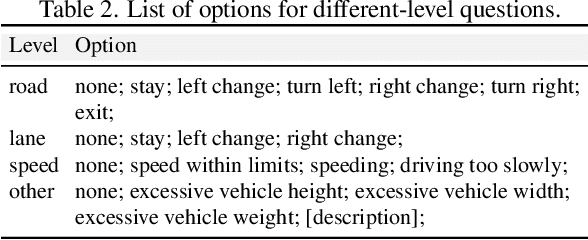
Abstract:Traffic signs play a key role in assisting autonomous driving systems (ADS) by enabling the assessment of vehicle behavior in compliance with traffic regulations and providing navigation instructions. However, current works are limited to basic sign understanding without considering the egocentric vehicle's spatial position, which fails to support further regulation assessment and direction navigation. Following the above issues, we introduce a new task: traffic sign interpretation from the vehicle's first-person view, referred to as TSI-FPV. Meanwhile, we develop a traffic guidance assistant (TGA) scenario application to re-explore the role of traffic signs in ADS as a complement to popular autonomous technologies (such as obstacle perception). Notably, TGA is not a replacement for electronic map navigation; rather, TGA can be an automatic tool for updating it and complementing it in situations such as offline conditions or temporary sign adjustments. Lastly, a spatial and semantic logic-aware stepwise reasoning pipeline (SignEye) is constructed to achieve the TSI-FPV and TGA, and an application-specific dataset (Traffic-CN) is built. Experiments show that TSI-FPV and TGA are achievable via our SignEye trained on Traffic-CN. The results also demonstrate that the TGA can provide complementary information to ADS beyond existing popular autonomous technologies.
ByteNet: Rethinking Multimedia File Fragment Classification through Visual Perspectives
Oct 28, 2024Abstract:Multimedia file fragment classification (MFFC) aims to identify file fragment types, e.g., image/video, audio, and text without system metadata. It is of vital importance in multimedia storage and communication. Existing MFFC methods typically treat fragments as 1D byte sequences and emphasize the relations between separate bytes (interbytes) for classification. However, the more informative relations inside bytes (intrabytes) are overlooked and seldom investigated. By looking inside bytes, the bit-level details of file fragments can be accessed, enabling a more accurate classification. Motivated by this, we first propose Byte2Image, a novel visual representation model that incorporates previously overlooked intrabyte information into file fragments and reinterprets these fragments as 2D grayscale images. This model involves a sliding byte window to reveal the intrabyte information and a rowwise stacking of intrabyte ngrams for embedding fragments into a 2D space. Thus, complex interbyte and intrabyte correlations can be mined simultaneously using powerful vision networks. Additionally, we propose an end-to-end dual-branch network ByteNet to enhance robust correlation mining and feature representation. ByteNet makes full use of the raw 1D byte sequence and the converted 2D image through a shallow byte branch feature extraction (BBFE) and a deep image branch feature extraction (IBFE) network. In particular, the BBFE, composed of a single fully-connected layer, adaptively recognizes the co-occurrence of several some specific bytes within the raw byte sequence, while the IBFE, built on a vision Transformer, effectively mines the complex interbyte and intrabyte correlations from the converted image. Experiments on the two representative benchmarks, including 14 cases, validate that our proposed method outperforms state-of-the-art approaches on different cases by up to 12.2%.
A Survey of Embodied Learning for Object-Centric Robotic Manipulation
Aug 21, 2024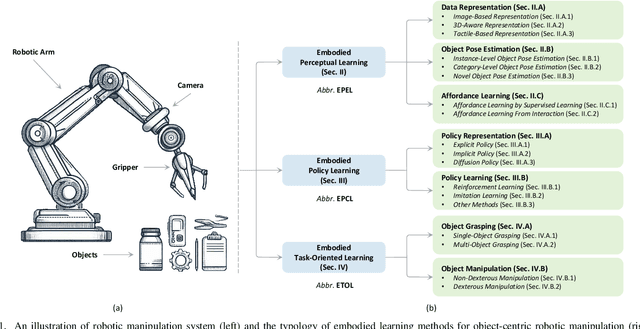
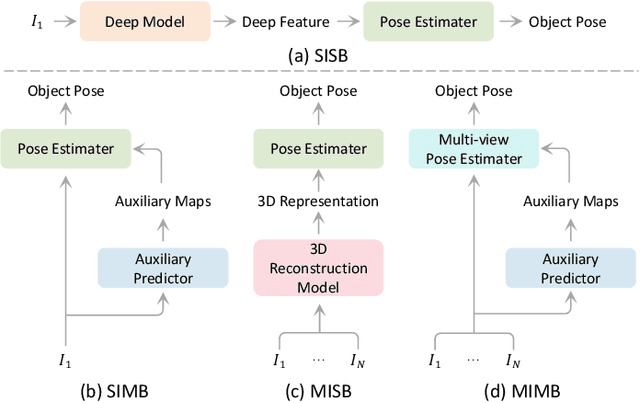
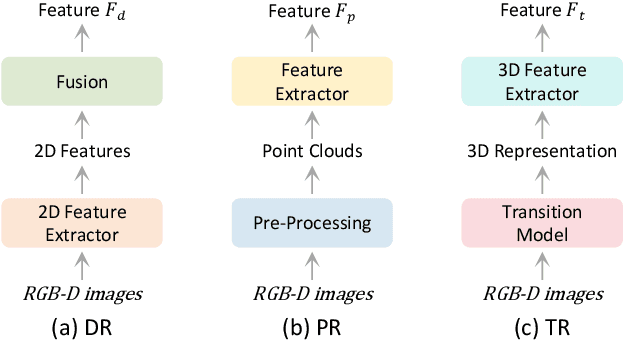

Abstract:Embodied learning for object-centric robotic manipulation is a rapidly developing and challenging area in embodied AI. It is crucial for advancing next-generation intelligent robots and has garnered significant interest recently. Unlike data-driven machine learning methods, embodied learning focuses on robot learning through physical interaction with the environment and perceptual feedback, making it especially suitable for robotic manipulation. In this paper, we provide a comprehensive survey of the latest advancements in this field and categorize the existing work into three main branches: 1) Embodied perceptual learning, which aims to predict object pose and affordance through various data representations; 2) Embodied policy learning, which focuses on generating optimal robotic decisions using methods such as reinforcement learning and imitation learning; 3) Embodied task-oriented learning, designed to optimize the robot's performance based on the characteristics of different tasks in object grasping and manipulation. In addition, we offer an overview and discussion of public datasets, evaluation metrics, representative applications, current challenges, and potential future research directions. A project associated with this survey has been established at https://github.com/RayYoh/OCRM_survey.
 Add to Chrome
Add to Chrome Add to Firefox
Add to Firefox Add to Edge
Add to Edge